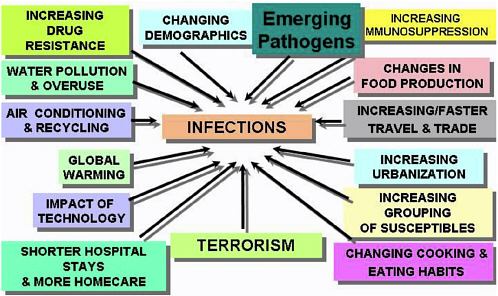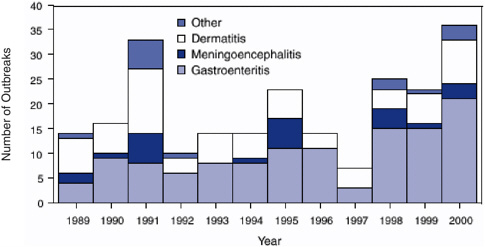3
Emerging Issues in Providing Safe Drinking Water*
Chemical and biological pollutants, whether from natural or human influence, that are regulated under various state, national, and international programs represent but a small fraction of the universe of chemicals present in the environment. The majority of contaminants are not regulated; however, this does not imply that they do not pose risks, according to some participants. Some contaminants are now being recognized as emerging pollutants—for example, those that have just gained entry to the environment, because they are new to industry—while other chemicals may be ubiquitous, but recent research has questioned their risk potential. During the workshop, a panel of speakers discussed the three types of emerging waterborne pollutants: (1) chemicals deposited from the atmosphere, (2) potentially risky chemicals brought to light by our ability to identify pollutants at lower and lower concentrations, and (3) microbes that are either newly discovered pathogens or long-established agents recently rendered more virulent. They further discussed a critical need by the scientific environmental research community to establish research and development priorities for developing advanced technology for environmental detection, measurement, and monitoring instrumentation technologies.
STATUS AND TRENDS IN ATMOSPHERIC DEPOSITION OF NITROGEN AND MERCURY IN THE UNITED STATES
The hydrologic cycle, which connects surface water, groundwater, and the atmosphere, provides many opportunities for contamination of drinking water, according to Mark Nilles of the U.S. Geological Survey. The influence of contamination by atmospheric deposition can occur by both wet deposition methods (when pollutants are purged from the atmosphere by rain, snow, sleet, or fog) and dry deposition methods, (e.g., gas and particle removal) in the absence of precipitation through gravity and uptake by vegetation. Three such chemicals—ammonia, nitrates, and mercury—can affect human health when nitrates and ammonia enrich aquatic ecosystems in excess and mercury bioaccumulates in aquatic food chains. With specific regard to these three contaminants, Nilles presented status and trend data derived from the National Atmospheric Deposition Program’s National Trends Network—a collection of monitoring sites spread across the nation—which is supported by numerous contributors both public and private, including a wide range of federal and state agencies. A long-term network with multiple sites, it enables researchers from many agencies to use the data to correlate emission trends with potential sources and human and ecological endpoints.
Ammonia
The U.S. Environmental Protection Agency’s (EPA’s) National Air Quality and Emissions Trends 1999 report revealed that ammonia emissions in the United States derive largely from agriculture, with approximately 72 percent from livestock and 16 percent from fertilizer application. This is atypical among dominant anthropogenic contaminants because the association or reported association is not from fossil fuel oxidation. Of 149 sites monitored for ammonia, 64 reported an increase in the rate of ammonium deposition, which was not associated with any particular region of the country. The status in 2002 was that ammonium ion wet deposition (see Figure 3.1) had a background deposition rate of approximately 0.2 kg per hectare. In primarily rural regions such as the Mississippi River basin, the level rose to approximately 5 kg per hectare.
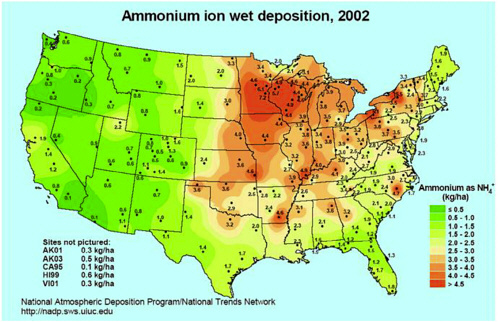
FIGURE 3.1 Ammonium ion wet deposition, 2002.
SOURCE: National Atmospheric Deposition Program, National Trends Network (NADP/NTN) (2004). Reprinted with permission.
Mercury
Mercury deposition, however, differs from both ammonia and nitrogen oxide depositions in its concentration and association. Mercury deposition is more complex, and comes from a wide variety of sources, the top four being utility coal boilers (40 percent), medical and municipal waste incineration (12 percent), other industrial boilers and heaters (10 percent), and chlorine production (5 percent). Highest concentrations in precipitation are observed in the Indiana-Minnesota-Wisconsin corridor whereas highest deposition is observed in the southeastern United States—a result of elevated concentration and greater amount of precipitation.
The trends for mercury are essentially indeterminate; however, because atmospheric deposition monitoring has not been established for long enough to determine trends, even though such deposition can account for some 50 to 75 percent of the mercury input to most aquatic ecosystems. EPA’s fish advisories on mercury have increased dramati-
cally in the last 10 years and now dominate fish consumption advisories in the United States (see Figure 3.2).
Nitrate
Whereas ammonia emissions correlate with agricultural areas, nitrogen oxides are strongly associated with industrial activities. Nitrogen oxide emissions are dominated by fossil fuel combustion, with transportation contributing 49 percent; utilities 27 percent; and industrial, commercial, or residential sources 19 percent. The highest concentrations of nitrogen oxide deposition are near areas of significant industrial activity and fossil fuel combustion, such as California, noted Nilles. The long-term trends have shown a slight increase in nitrate in the West, while the northeastern United States has experienced a downward trend; however, few of these trends are environmentally significant, concluded Nilles (see Figure 3.3).
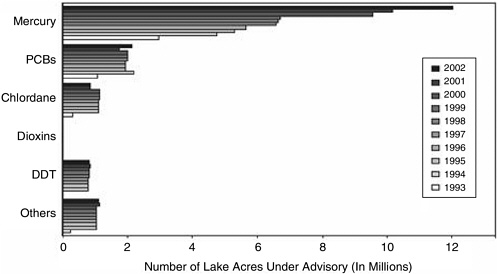
FIGURE 3.2 While the number of lakes under advisory for a number of contaminants has remained relatively steady since 1993, mercury advisories have risen threefold.
SOURCE: Nilles (unpublished). Reprinted with permission.
Moreover, even though nitrogen deposition rates in the farm states are relatively high compared to those of nonagricultural regions, the percentage of total nitrogen input in the Midwest is low because direct runoff from fertilizer application is higher in these regions. Therefore, while approximately 19 percent of the total nitrogen in New York and Connecticut’s Long Island Sound comes from atmospheric deposition, this phenomenon accounts for less than 5 percent in the Mississippi River as well as in other water bodies in that region.
NONREGULATED CONTAMINANTS: OLD POLLUTANTS, NEW CONCERNS; NEW POLLUTANTS, UNKNOWN ISSUES
Although some emerging pollutants have recently been released into the environment, it is important to recognize that the vast majority of
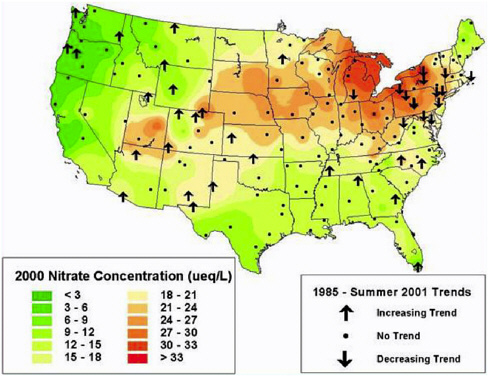
FIGURE 3.3 U.S. nitrate trends in precipitation have shown some sites in the United States (the West) with modest increases in concentration, while other regions have shown slight decreases.
SOURCE: USEPA (2003). Reprinted with permission.
recently identified potential pollutants were previously unrecognized and are of interest as a result of advances in chemical analysis—our ability to identify pollutants at lower and lower concentrations, said Christian Daughton of the EPA. Daughton noted that there are more than 22 million known organic and inorganic substances, of which nearly 6 million are commercially available. Yet only 250,000 of those 6 million—about 1 percent of the known chemical universe—have been inventoried or regulated by any countries throughout the world.
The agenda for regulation is far narrower still. Since the 1970s, it has focused almost exclusively on conventional pollutants such as persistent, bioaccumulative, toxic (PBT) pollutants; persistent organic pollutants (POPs); or bioaccumulative chemicals of concern (BCCs)—a subset of which are the “dirty-dozen” halogenated organics including DDT (dichlorodiphenyltrichloroethane) and PCBs (polychlorinated biphenyls). These pollutants are only one small piece of the larger risk puzzle, said Daughton. Many other chemicals, including a number of consumer goods and pharmaceutical agents, have routinely been neglected, ignored, or omitted. Yet because this latter category is for all practical purposes unlimited, thresholds must be established in practice.
Given the wide range of pollutants to which an organism is exposed, for example, as a result of drinking water, some portion of the overall risk derives from unregulated pollutants, which compose the majority of chemicals in any water sample. Not all of them are necessarily harmful, noted Daughton. While assessing this risk, one must remember that not everything that can be measured is worth measuring and not everything worth measuring is measurable. There are multiple dimensions to consider in assessing holistic risk posed by exposure. According to Daughton, the four most important of these dimensions, called the four Ts, are toxicants (i.e., their identities), totality of the chemicals or doses, tolerance (i.e., resistance of homeostasis to perturbations), and trajectory (i.e., dynamic variations in stressor types and concentrations over time). All together, they form the foundation for understanding the overall true risk, which at present no one is really capable of determining. Ascertaining the toxicological significance of multiple trace-level exposures will require a better understanding of factors such as additive effects, interactive effects including synergisms, and
|
Scientists need to reevaluate what constitutes persistence. Chemicals that have short environmental half-lives can still be persistent if they are continually reintroduced into water. Christian Daughton |
nontarget species receptor repertoires. For example, drugs, which were not developed for any organism in the environment other than people or domestic animals, could have numerous mechanisms of action in diverse niches of ecological cycles that ultimately affect humans. Moreover, scientists need to reevaluate what constitutes persistence, said Daughton. Chemicals that have short environmental half-lives can still be persistent if they are continually reintroduced into water, for example, via sewage.
Meanwhile, as researchers seek the important missing pieces of the larger holistic risk puzzle, we should employ early-warning water monitoring. Based on change detection, this would not target an impossibly long and ever-growing list of target analyses but would respond only to contaminants that are newly present. For example, a low-cost, rapid monitoring system could be deployed nationwide for detecting unanticipated effects of technology on the environment. Early-warning water monitoring also could be very useful with respect to homeland security, suggested Daughton, because it would minimize the chances of widespread effects resulting from surreptitious sabotage of water systems and would be very important for maintaining and solidifying public trust in water supplies. Ultimately, after-the-fact detection and remediation should be supplanted by pollution prevention and stewardship programs, which also can be less costly. Unfortunately, the drinking water and wastewater infrastructures—which are critical to such programs—have both been decaying. A study by the American Society of Civil Engineers, for example, concluded that these infrastructures currently merit nationwide grades of D and that $20 billion would be required annually merely to keep them where they are right now without further decay.
It is a question not only of securing the needed financial resources, noted Daughton, but of maintaining and improving the public’s confidence in water supplies. It is important that we maintain the public’s trust in order to successfully respond to the growing pressures to reuse wastewaters for drinking. The two major issues in this area are (1) groundwater recharge, whether direct or indirect and (2) decentralized water reuse, the epitome of which is referred to as “toilet-to-tap” programs. Taking water from the toilet, treating it onsite, and reusing it as drinking water would obviously be the ultimate, though not untypical, application. Technologically, this is feasible but the question is: Would the public ever accept it? Daughton suggested that the public would, as long as the communication of risk—low risk, in this case—is given greater priority. This highlights the need for scientists to better convey the significance of their work to the public. It is very important that we discern better ways
to get scientists engaged in doing so, especially with regard to resolving the sometimes diametrically opposed views of risks held by scientists and the public. This has to do with the difference between real hazards and risk perception. One way of addressing this disconnect, proposed Daughton, would be to involve the cognitive science community substantively. Social scientists and psychologists should be used more frequently in helping to bridge this gap in communication between scientists and the public, however, getting bench researchers to collaborate and communicate more fully with social scientists would be a challenge in its own right.
PATHOGENS IN WATER: ADDRESSING A PUBLIC HEALTH THREAT VIA THE POTENTIAL SYNERGISM OF THE CLEAN WATER ACT AND THE SAFE DRINKING WATER ACT
It has been 10 years since the deadly Cryptosporidium outbreaks in water supplies, observed Joan Rose of Michigan State University, but we have not made as much progress during those years as we could have in addressing emerging waterborne pathogens. The zoonotic class of waterborne pathogen, of which Cryptosporidium is a classic example, is excreted in large numbers by humans and animals, survives very well in the environment, and is resistant to water treatment (see Figure 3.4).
These emerging pathogens, derived largely from fecal waste in sewage discharges, septic tanks, combined sewer overflows, stormwater, and agricultural runoff, are of concern for both wastewater treatment and drinking water treatment. Therefore, they must be regulated by the Clean Water Act as well as the Safe Drinking Water Act, which to date have only spottily addressed pathogens and have largely failed to complement each other, asserted Rose.
|
Societal changes, occurring in both the developing and developed worlds, have contributed to greater exposure or susceptibility to emerging diseases or diseases previously thought to be under control. Joan Rose |
In industrialized countries, public health has made significant progress in containing and eliminating outbreaks as a result of infectious agents. However, noted Rose, many societal changes, occurring in both the developing and the developed worlds, have contributed to greater

FIGURE 3.4 Chemical analysis output for a typical environmental sample.
SOURCE: Daughton (2002). U.S. Environmental Protection Agency. Reprinted with permission.
exposure or susceptibility to emerging diseases or diseases previously thought to be under control. Drivers of increased risk of waterborne pathogens in particular include population growth and demographic changes, associated with increased generation and concentration of human wastes; the aging wastewater and drinking water infrastructures; greater exposure to emerging zoonotic agents; and climate change with precipitation, wind, and temperature shifts aiding in the transport and survival of the contaminants (see Figure 3.5).
Given these societal changes or circumstances, outbreaks of infectious disease do and will occur. Also, although scientific and public health professionals have generally been able to control major outbreaks, these outbreaks are estimated to account for only 5–10 percent of the waterborne disease in any community, and they are increasing according to the latest statistics from the Centers for Disease Control and Prevention (see Figure 3.6). Numerous outbreaks continue to occur in the smaller water supply systems, which do not have as much opportunity for monitoring or investing in treatment technology and upgrades, for both groundwater and ambient waters.
Meanwhile, knowledge of microorganisms on EPA’s current Contaminant Candidate List has not proceeded very far, according to Rose, because there has not been sufficient investment in understanding the occurrence of these contaminants in water, the potential for exposure, and the health outcomes. Yet even if progress had indeed been made in terms of these pathogens, it would be only the beginning. We have cultivated approximately 1 percent of the organisms that might be found in wastewater (i.e., from the intestinal tract) and might be associated with disease. In addition to the new pathogens being discovered every year, researchers are learning not only of the roles of infectious agents in health risk end points such as diarrhea, but also of the increasing role of infectious agents in chronic diseases such as ulcers, Guillain-Barré syndrome, and some cancers.
Many of the emerging pathogenic bacteria—including Campylobacter, Salmonella, Cryptosporidium, Giardia, Mycobacterium paratuberculosis, and new and deadly forms of the ubiquitous Escherichia coli—are zoonotic. Even a traditional pathogen like Salmonella is showing up in a new bovine form, called Salmonella newport, that constitutes approximately 10 percent of all human Salmonella infections, yet is resistant to numerous antibiotics. These pathogens, and hundreds of others associated with animal wastes, are now present in human sewage. Similarly, wastewaters contain some 130 viruses that are enteric, respiratory, or both, reported Rose. Coxsackie viruses in particular, which cause not only diarrhea and respiratory disease but myocarditis, diabetes, encephalitis, and meningitis, are the most common. Adenoviruses also are being found in high concentrations in wastewater, as well as in tap water. These pathogens are a great concern or risk for small communities and for those individuals reliant on groundwater—groups that are already seeing an increase in the number of outbreaks—of both in respect to acute and chronic diseases.
As we move forward, we will face a number of challenges, concluded Rose, including the following:
-
To engineer ultraviolet (UV) disinfection to be effective against pathogens such as adenoviruses, which are now largely resistant to it. This is paramount because UV has been displacing chlorination, whose discharges are seen to be environmentally damaging.
-
To study certain cancer-causing viruses, polyoma viruses, now being found in sewage at fairly high concentrations. Little is known about these single-stranded DNA viruses’ survival or resistance to
-
wastewater treatment or wastewater disinfection and of the role of water in transmission of the viruses.
-
To develop the research agenda to include studies of sources, transport, ambient waters, and groundwaters and to focus on risk outcomes.
-
To complement in practice two inherently related but often separately administered pieces of legislation namely, the Clean Water Act (CWA), which addresses human health largely through recreational exposure and the Safe Drinking Water Act (SDWA), which addresses human health through exposure to tap water.
The CWA focus has been reactive, with epidemiological data used to set national guidelines, while regulation under the SDWA has established a Maximum Contaminant Level Goal of zero tolerance for pathogens, followed by treatment technology. The SDWA assumes that all waters are at risk, said Rose, and that if we treat the water appropriately, we are going to be safe.
Pathogen monitoring and risk assessment have been done under the CWA, but for ecological end points and not public health. With the SDWA, by contrast, monitoring and risk assessment have been used extensively, and sensitive populations have been included. Neither act has begun regulating emerging pathogens, she noted, although the SDWA has included them on its Contaminant Candidate List for analysis of occurrence and health risk.
The CWA does offer an abundance of watershed tools, however, for examining the effects of combined animal feeding operations, sanitary sewer overflows, combined sewer overflows, and septic tanks on public health. If we focus on the watershed tools that the Clean Water Act provides and continue through the continuum of using a risk assessment approach, together with better monitoring to identify contaminants of concern, we are going to emerge with the ability to put our dollars where we need them, said Rose. We will better protect our waters from the perspective of both the Clean Water Act and the Safe Drinking Water Act and be able to achieve long-term water quality sustainability as well.

